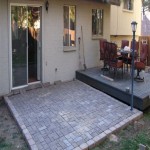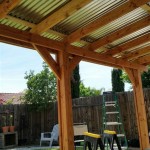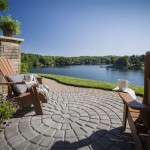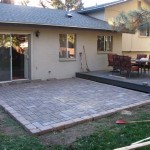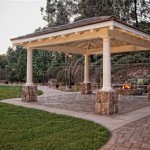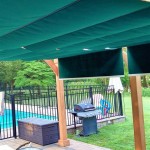How To Repair Concrete Patio Table Tops
Concrete patio tables offer a durable and aesthetically pleasing addition to outdoor spaces. Built to withstand the elements, they often serve as focal points for gatherings and relaxation. However, despite their robust nature, concrete table tops are susceptible to damage over time. Exposure to weather, impact from objects, and general wear and tear can lead to cracks, chips, and surface imperfections. Fortunately, repairing a concrete patio table top is a manageable project that can restore its appearance and extend its lifespan. This article provides a comprehensive guide to the process, outlining the necessary steps and materials for successful repair.
Before embarking on any repair project, a thorough assessment of the damage is crucial. This evaluation will determine the scope of the repair and the specific products required. Minor surface imperfections, such as hairline cracks or small chips, may necessitate only a simple patching compound. More extensive damage, like large cracks or significant spalling (where the surface of the concrete flakes or crumbles), will require more extensive repairs, potentially involving concrete resurfacers or even partial reconstruction. Understanding the nature and extent of the damage will ensure that the appropriate repair strategy is employed.
Once the damage has been assessed, gathering the necessary tools and materials is the next essential step. This preparation streamlines the repair process and minimizes potential delays. The specific tools and materials will vary depending on the nature of the damage, but a standard toolkit will generally include a wire brush, a chisel and hammer (for removing loose concrete), a mixing bucket, a trowel or putty knife, safety glasses, gloves, and a dust mask. Material-wise, one will need concrete patching compound, concrete resurfacer (if the damage is extensive), water, and potentially a concrete sealer for protection after the repair.
Preparing the Damaged Concrete Surface
Proper surface preparation is paramount to achieving a lasting and aesthetically pleasing repair. The goal is to create a clean, stable, and slightly rough surface that will allow the repair materials to bond effectively. This process typically involves several key steps, each designed to ensure optimal adhesion and longevity of the repair.
The first step in surface preparation is cleaning. This involves removing any loose debris, dirt, oil, grease, algae, or other contaminants that may be present on the surface of the concrete. A wire brush is ideal for scrubbing the affected area, dislodging loose particles. For stubborn stains or contaminants, a concrete cleaner or degreaser can be used. The surface should then be thoroughly rinsed with water to remove any residual cleaning agents.
The next step is to remove any loose or crumbling concrete. This can be achieved using a chisel and hammer. Carefully chip away at the damaged areas, ensuring that all unsound concrete is removed. Avoid excessive hammering, as this can further damage the surrounding concrete. The objective is to create a solid base for the repair material to adhere to.
If the surface of the concrete is smooth, it may be necessary to roughen it up to improve adhesion. This can be accomplished by using a wire brush, a grinding wheel, or by acid etching. Acid etching should be done with extreme caution, following all safety instructions provided by the manufacturer. Regardless of the method used, the goal is to create a slightly textured surface that will provide a better grip for the repair material.
Finally, before applying any repair materials, the surface should be dampened with water. This helps to prevent the concrete from drawing moisture out of the repair material too quickly, which could lead to cracking or poor adhesion. However, the surface should not be soaking wet; it should be damp to the touch.
Repairing Cracks and Chips
Once the surface has been properly prepared, the actual repair process can begin. For minor cracks and chips, a concrete patching compound is typically sufficient. Patching compounds are designed to fill in small imperfections and restore the surface to its original condition. The application process generally involves mixing the compound according to the manufacturer's instructions, applying it to the damaged area, and smoothing it out with a trowel or putty knife.
When mixing the patching compound, it is important to follow the manufacturer's instructions carefully. Adding too much water can weaken the compound, while adding too little can make it difficult to work with. The goal is to achieve a consistency similar to that of thick paste. Mix the compound thoroughly to ensure that all of the ingredients are properly combined.
Apply the patching compound to the damaged area, using a trowel or putty knife to press it firmly into the crack or chip. Ensure that the compound fills the entire void and is level with the surrounding concrete surface. For deeper cracks or chips, it may be necessary to apply the compound in multiple layers, allowing each layer to dry before applying the next.
Once the patching compound has been applied, use a trowel or putty knife to smooth it out and blend it seamlessly with the surrounding concrete surface. Pay attention to the edges of the repair, ensuring that they are flush with the existing concrete. If necessary, use a damp sponge to further smooth out the surface and remove any excess compound.
Allow the patching compound to dry completely according to the manufacturer's instructions. This may take several hours or even overnight, depending on the type of compound used and the ambient temperature. Avoid walking on or otherwise disturbing the repaired area until it is fully dry.
Repairing Spalling and Surface Deterioration
For more extensive damage, such as spalling or widespread surface deterioration, a concrete resurfacer may be necessary. Concrete resurfacers are designed to provide a thin layer of new concrete over the existing surface, concealing imperfections and restoring the overall appearance of the table top. The application process typically involves preparing the surface as described above, mixing the resurfacer according to the manufacturer's instructions, and applying it to the entire surface using a squeegee or trowel.
Before applying the concrete resurfacer, it is crucial to ensure that the existing concrete surface is structurally sound. Any loose or crumbling concrete must be removed, and any cracks or chips should be filled in with patching compound. The surface should also be thoroughly cleaned and dampened to promote adhesion.
When mixing the concrete resurfacer, it is important to follow the manufacturer's instructions carefully. The consistency of the mixture should be similar to that of a thin slurry. Mix the resurfacer thoroughly to ensure that all of the ingredients are properly combined and that there are no lumps or clumps.
Apply the concrete resurfacer to the entire surface of the table top, using a squeegee or trowel to spread it evenly. Ensure that the entire surface is covered with a thin, consistent layer of resurfacer. For best results, apply the resurfacer in multiple thin coats, allowing each coat to dry before applying the next.
Once the resurfacer has been applied, use a squeegee or trowel to smooth it out and create a uniform surface. Pay attention to the edges of the table top, ensuring that they are smooth and even. If desired, a texture can be added to the surface using a broom or other texturing tool.
Allow the concrete resurfacer to dry completely according to the manufacturer's instructions. This may take several days, depending on the type of resurfacer used and the ambient temperature. Avoid walking on or otherwise disturbing the repaired area until it is fully dry.
After the concrete has been repaired, consider applying a concrete sealer to protect it from future damage. Concrete sealers create a barrier against moisture, stains, and other contaminants, helping to extend the lifespan of the repair and maintain the appearance of the table top.
Sealers come in a variety of types, including penetrating sealers and film-forming sealers. Penetrating sealers soak into the concrete, providing protection from within, while film-forming sealers create a protective layer on the surface of the concrete. The choice of sealer will depend on the specific needs of the project and the desired appearance of the finished product.
Before applying the sealer, ensure that the concrete surface is clean and dry. Apply the sealer according to the manufacturer's instructions, using a brush, roller, or sprayer. Apply multiple thin coats of sealer, allowing each coat to dry before applying the next. Avoid applying too much sealer, as this can lead to a cloudy or blotchy appearance.
Regular maintenance, such as cleaning and resealing, will help to keep the concrete patio table top looking its best for years to come. By following these simple steps, one can effectively repair and protect a concrete patio table top, ensuring its longevity and aesthetic appeal.

How Should I Refinish Our Concrete Table Top Hometalk

Cement Coating An Outdoor Table

Diy Concrete Table Top She Holds Dearly

Concrete Countertops How To Fix A Rough Or Imperfect Surface

How To Repair And Resurface Old Concrete Patios Fixing Ugly

How To Repair Glass Patio Table Problems

Help Repairing Stone Patio Table Doityourself Com Community Forums

Diy Concrete Table Top She Holds Dearly

How To Repair Glass Patio Table Problems

Diy Concrete Table Top She Holds Dearly
Related Posts

